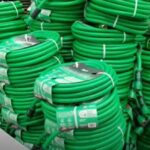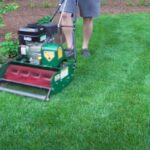Are you dreaming of a lush, green lawn that feels like a soft carpet under your feet? Zoysia grass could be the answer to your yard goals.
But just like any living thing, it needs proper nourishment to thrive. If you’re wondering how to fertilize Zoysia grass effectively, you’ve come to the right place. You’ll discover simple yet powerful techniques to keep your Zoysia grass healthy and vibrant.
Imagine transforming your yard into the envy of your neighborhood. Unlock the secrets to a stunning lawn that invites compliments and creates a welcoming outdoor space for your family. Let’s dive into the steps that will turn your lawn dreams into reality.
You May Like
- 50 Plugs per tray (covers 50 square feet) (1.5″ x 1.5″ Plugs)
- Grows into a beautiful low maintenance lawn – Mature plugs are already…
- Excellent cold and drought tolerance
- Use in full sun and partial shade. Zoysia Plugs ordered in fall/winter will…
- Zoysia grass seed & mulch is designed for full sun and light shade
- Combines mulch and grass seed to grow a tough, durable, low-maintenance…
- Extremely versatile seed mix that’s 99.9% weed free
- Thrives in heat, drought and partial shade
- DECEMBER – APRIL Zoysia Plugs will ship DORMANT and arrive golden brown!
- This product will have a slightly longer lead time to allow for U.S….
- Water daily for first 14 days! 1 hour of water/day for 2 weeks after…
- Plug size is 1.5″x1.5″.
- 16-Count Zoysia SodPods: Includes 2 trays of 8-count Pods (16 total). Each…
- Coverage Area: Once fully matured, each 16-count pack covers 36-sq ft when…
- Premium Texture: Dense, fine-bladed grass with soft, carpet-like feel and…
- Sunlight Needs: Grows well in full sun to partial shade; highly adaptable…
Zoysia Grass Basics
Zoysia grass is soft and green. It grows well in warm places. This grass needs care to stay healthy. Fertilizing helps it grow strong. A good lawn starts with healthy grass.
Zoysia grass likes the sun. It does not need too much water. This grass is great for lawns. It feels good underfoot. Kids and pets love playing on it.
Fertilizer gives Zoysia grass food. It helps the grass grow thick. Fertilizers have nutrients. These nutrients are nitrogen, phosphorus, and potassium. They are important for plant health.
Choosing The Right Fertilizer
Zoysia grass is popular in lawns. It needs the right care. Understanding its nutrient needs is important. This grass needs nitrogen, phosphorus, and potassium. Each nutrient helps the grass grow well. Nitrogen makes it green and lush. Phosphorus helps roots grow strong. Potassium keeps the grass healthy. It fights diseases. A good balance of these helps Zoysia thrive.
There are two main fertilizer types. Organic and inorganic. Organic fertilizers come from plants or animals. They release nutrients slowly. This keeps the soil healthy. Inorganic fertilizers are made in factories. They give nutrients fast. Choose the type that suits your lawn needs. Check the label for the right nutrient mix.
Fertilization Schedule
Zoysia grass loves spring and summer. It grows best in these seasons. Fertilize in early spring when grass turns green. This helps it wake up from winter. Use fertilizer again in late spring. This keeps the grass healthy. In mid-summer, give it another feeding. This supports strong growth. Do not fertilize in fall or winter. The grass rests then.
Apply fertilizer three times in the growing season. Start in spring. Then fertilize every 6-8 weeks. This keeps the grass strong. Over-fertilizing can hurt the grass. Follow the schedule for best results. Always read the fertilizer package. It gives exact amounts to use.
Application Techniques
Broadcast spreading is a simple way to fertilize zoysia grass. It covers large areas evenly. Use a fertilizer spreader for this method. Walk steadily while spreading the fertilizer. Follow the instructions on the package. This helps avoid over-fertilizing.
Measure the area before starting. This ensures you use the right amount. It’s important to spread in straight lines. Overlapping can cause uneven growth. Check the weather before you start. Avoid windy days for spreading. Wind can blow the fertilizer away. Water the grass after spreading. This helps the nutrients soak in. Keep pets and children off the grass. Let the fertilizer settle for a while.
Fertilizer spreaders make the job easy. Choose the right spreader for your lawn size. Push spreaders are good for small lawns. Tow-behind spreaders fit large lawns. Adjust settings before use. This controls how much fertilizer is spread.
Fill the hopper with the fertilizer. Avoid filling it too high. Start at one end of the lawn. Walk slowly and evenly. Cover every part of the grass. Overlap slightly for even coverage. Clean the spreader after use. This keeps it in good condition.
Watering After Fertilization
Watering is crucial after fertilizing zoysia grass. It helps the soil absorb nutrients. This ensures the grass gets all it needs. Roots grow stronger with proper watering. Nutrients move deep into the soil. This supports healthy grass growth.
Water early in the morning or late afternoon. This prevents quick evaporation. Aim for about one inch of water weekly. Deep watering is better than frequent, shallow watering. It encourages deep root growth. Avoid watering during the hottest part of the day. This can harm the grass and waste water.

Credit: www.youtube.com
Avoiding Common Mistakes
Over-fertilizing Zoysia grass can harm it. The grass may grow too fast. This can lead to weak roots. Weak roots can’t hold the grass well. It may turn yellow or brown.
This means the grass is stressed. It becomes more prone to disease. Too much fertilizer can also harm the soil. It can wash into rivers and lakes. This pollutes the water. Always use the right amount of fertilizer. Follow the instructions on the bag. This keeps your grass healthy and strong.
Zoysia grass needs nutrients to stay green. If the grass is pale, it might need more food. Slow growth is another sign. The grass may look thin or patchy. These are signs of under-fertilization. Nutrients help grass grow strong. Without them, it cannot thrive. Feed your grass properly. It will grow lush and green. Check the soil if unsure. It will tell you what the grass needs.
Organic Fertilizing Options
Organic fertilizers are kind to the earth. They enrich the soil with natural nutrients. These nutrients help grass grow strong. No chemicals harm the soil or water. Organic fertilizers improve soil structure. They make soil hold water better. This helps grass stay green and healthy. Organic choices are safe for pets and kids. They do not cause allergies or health issues. Using organic fertilizers supports environmental sustainability.
| Fertilizer Type | Main Benefit |
|---|---|
| Compost | Rich in nutrients |
| Manure | Improves soil texture |
| Bone Meal | High in phosphorus |
| Fish Emulsion | Quick nutrient release |

Credit: houstonturfgrass.com
Monitoring Lawn Health
Fertilizing Zoysia grass enhances lawn health by providing essential nutrients. Choose a balanced fertilizer suitable for Zoysia. Apply during active growth periods, usually late spring and early summer, to ensure optimal nutrient absorption. Regular monitoring helps maintain lush, green turf.
Identifying Nutrient Deficiencies
Zoysia grass needs the right nutrients to grow well. Yellow leaves can show a lack of nitrogen. Thin grass patches might need more phosphorus. Slow growth could mean a lack of potassium. Check grass color and growth often. This helps spot problems early.
Adjusting Fertilization Strategy
Change your fertilizing plan based on grass needs. Use a balanced fertilizer for general care. Add more nitrogen if leaves are yellow. Use phosphorus for thin patches. Potassium can help with strong roots. Follow instructions on fertilizer bags. Too much can harm grass.
Frequently Asked Questions
What Is The Best Time To Fertilize Zoysia Grass?
The best time to fertilize Zoysia grass is during late spring. This is when the grass is actively growing. Applying fertilizer in early summer also promotes optimal growth and health. Avoid fertilizing in late fall or winter to prevent damage.
How Often Should I Fertilize Zoysia Grass?
Fertilize Zoysia grass three times per year. Apply during late spring, mid-summer, and early fall for best results. Over-fertilizing can harm the grass, so avoid frequent applications. Use a balanced fertilizer to promote healthy growth.
What Type Of Fertilizer Is Best For Zoysia Grass?
A balanced, slow-release fertilizer is best for Zoysia grass. Choose one with equal parts nitrogen, phosphorus, and potassium. This ensures steady nutrient supply and prevents burning. Organic options are also effective and environmentally friendly.
Can I Fertilize Zoysia Grass In The Fall?
Yes, you can fertilize Zoysia grass in early fall. Use a slow-release fertilizer to prepare for winter. This helps the grass store nutrients and strengthens it for the cold months. Avoid late fall applications to prevent growth issues.
Conclusion
Fertilizing Zoysia grass keeps it healthy and vibrant. Regular care ensures lush growth. Use the right type of fertilizer for best results. Always follow the recommended schedule. Avoid over-fertilizing to prevent damage. Water the grass after applying fertilizer. This helps nutrients reach the roots.
Healthy Zoysia grass boosts your lawn’s beauty. Enjoy the green, soft carpet under your feet. A little effort goes a long way. Your lawn will thank you for it. Keep learning and caring for your Zoysia. It’s worth the time and attention.
Happy gardening!








